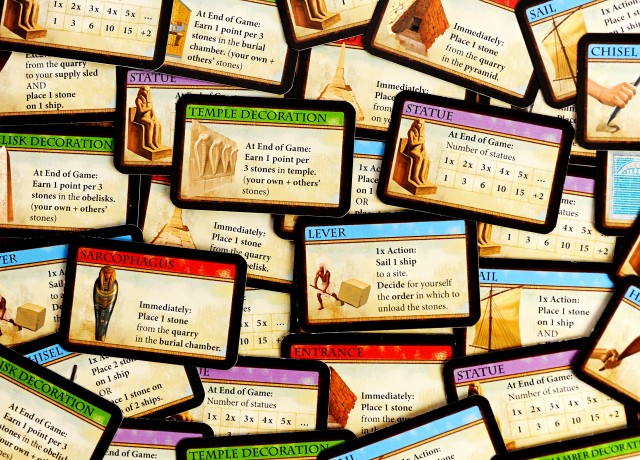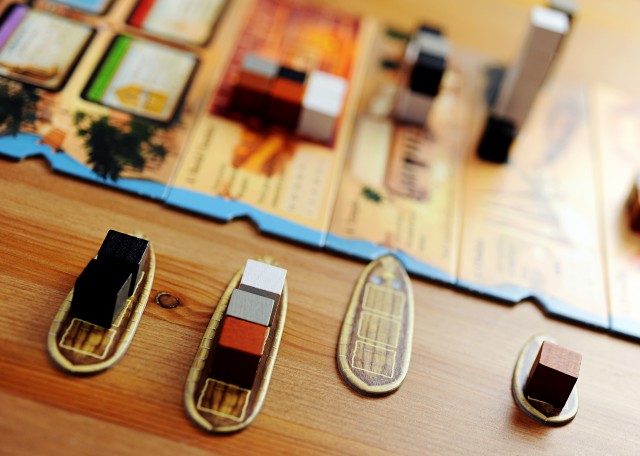I was recently listening to an episode of the always informative and interesting Vox Republica podcast, where Erin and Ryan discussed their thoughts behind how many times you should play a game before you pass judgement on it – both as a gamer, and also as a gamer who reviews games. I must admit, I try my hardest to play a game a couple of times before reviewing it, but sometimes I’ll give my first impressions instead – for Imhotep, I’ve had the time to take it a few times around the block! I picked it up a few days after the Spiel des Jahres winner for game of the year was announced. Spoiler alert: Imhotep didn’t win. But it really, really deserved that nomination – and now, having played it a good number of times since then, I feel like I can explain just what it is that makes Imhotep a great game.
 The basic premise of the game is that each player is a builder in Egypt trying to emulate the legendary architect, Imhotep. You’ll be bringing stones from the quarry to your personal supply, then putting them on ships and sailing them to various construction sites – the market, pyramids, burial temple or obelisks. After 6 rounds of play, the builder with the most victory points wins. The simplicity of the game, and the basic actions of each turn – excavate stone/s, load a stone onto a ship, move a ship, or play a card – mean the game is strikingly easy to teach and to learn. But the game isn’t all just about these simple actions – these actions turn into really tough choices about how and when to act to benefit yourself, versus how and when to thwart your opponents.
The basic premise of the game is that each player is a builder in Egypt trying to emulate the legendary architect, Imhotep. You’ll be bringing stones from the quarry to your personal supply, then putting them on ships and sailing them to various construction sites – the market, pyramids, burial temple or obelisks. After 6 rounds of play, the builder with the most victory points wins. The simplicity of the game, and the basic actions of each turn – excavate stone/s, load a stone onto a ship, move a ship, or play a card – mean the game is strikingly easy to teach and to learn. But the game isn’t all just about these simple actions – these actions turn into really tough choices about how and when to act to benefit yourself, versus how and when to thwart your opponents.
Your main aim, as one of these Very Important Builders, is to, well – build stuff! The only exception to this is the market, where you’ll exchange stones for cards, which will either give an immediate benefit (like adding stones to structures), an action card to play in a following turn, or game end set-based points for statue cards. While you’re shuffling your stones onto ships, you may very well have a great plan for where they’d go to benefit you in the best way possible – however, if another player sharing that ship wants to do something else, they may very well sail to the construction site you don’t want any part of. Because, while there are a variety of sites, it’s pretty hard to do everything well in Imhotep. You need to focus on a few things and do those moderately to really well, in order to pile up those points.
In the basic (A side) game, the market allows you to take one face up card for each stone you exchange – usually, these will be helpful, so if you end up at the market without meaning to, it won’t be so bad. Pyramids will score immediately for each stone you build (variable depending on their position in the pyramid). The temple scores out at the end of each round, a point per stone visible from above the structure (this one is tricky, and quite important  when considering the order stones are loaded off the ship!). The burial chamber and obelisk are both scored at the end of the game, to give you enough time to work on them so you don’t end up with too little in the chamber, or some sort of sad nubbin rather than a majestic obelisk. The chamber scores out by rewarding areas of connected stones, and the obelisk rewards those players who built the tallest.
when considering the order stones are loaded off the ship!). The burial chamber and obelisk are both scored at the end of the game, to give you enough time to work on them so you don’t end up with too little in the chamber, or some sort of sad nubbin rather than a majestic obelisk. The chamber scores out by rewarding areas of connected stones, and the obelisk rewards those players who built the tallest.
As I mentioned, it’s really hard to do all of these things well. Especially when, despite your best intentions, other players can really put a chisel in the works if they ship to a site you’re not interested in. For me, this is one of the most exciting things in the game, and what keeps it really fresh. It lets you try different tactics each game, and try to work on the fly and change strategies in-game to make the best of your situation. There are aspects of “I’ll do this to benefit me, and also mess with other players” but you can also go straight out “take that” to other players if you can tell what they’re aiming to do in any given round. On top of the variability of strategies within game, and from game to game, the B side of the boards (each site, slightly tweaked) means you can mix things up a little once you’ve played the game a few times – again keeping things fresh. And with the board being modular, you can actually mix things up, which is something I haven’t seen before.
On the production side of things, everything really is top-notch, which I’ve come to expect from Kosmos games. The art is really well-done, and evocative of the theme in all areas of the game – the board, the cards and even the little ships. The components are quality (no flimsy board or cards) and the cubes representing stones are really nice and tactile – I was honestly expecting them to be a little odd to play with given their size, but they’re perfect! There’s something really wonderful about how the quality of a game’s production elevates the experience of play, and this is certainly no exception.
Imhotep really hits a sweet spot for me – it’s easy to introduce to new players, there’s a decent amount of player interaction, and the game having a set amount of rounds means the playing time really is accurate to what’s on the box. A great strategy game under an hour with this much replay factor is a definite keeper for my shelves!
Imhotep, designed by Phil Walker-Harding, is a game for 2 – 4 players from Kosmos, and the approximate play time is 40 minutes.
Comments
No comments yet! Be the first!